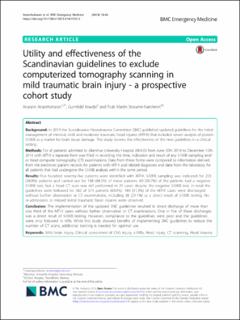| dc.contributor.author | Ananthaharan, Arurann | |
| dc.contributor.author | Kravdal, Gunnhild | |
| dc.contributor.author | Straume-Næsheim, Truls Martin | |
| dc.date.accessioned | 2022-12-08T13:02:27Z | |
| dc.date.available | 2022-12-08T13:02:27Z | |
| dc.date.created | 2018-11-23T10:07:53Z | |
| dc.date.issued | 2018 | |
| dc.identifier.citation | BMC Emergency Medicine. 2018, 18:44 (1), 1-8. | en_US |
| dc.identifier.issn | 1471-227X | |
| dc.identifier.uri | https://hdl.handle.net/11250/3036798 | |
| dc.description.abstract | Background
In 2013 the Scandinavian Neurotrauma Committee (SNC) published updated guidelines for the initial management of minimal, mild and moderate traumatic head injuries (MTHI) that included serum analysis of protein S100B as a marker for brain tissue damage. This study reviews the effectiveness of the new guidelines in a clinical setting.
Methods
For all patients admitted to Akershus University Hospital (AHUS) from June 30th 2014 to December 15th 2014 with MTHI a separate form was filled in recording the time, indication and result of any S100B sampling and/or head computer tomography (CT) examinations. Data from these forms were compared to information derived from the electronic patient records for patients with MTHI and related diagnoses and data from the laboratory for all patients that had undergone the S100B analysis within the same period.
Results
Five hundred seventy-five patients were identified with MTHI, S100B sampling was indicated for 223 (38.8%) patients and carried out for 188 (84.3%) of these patients. 69 (36.7%) of the patients had a negative S100B test, but a head CT scan was still performed in 31 cases despite the negative S100B test. In total the guidelines were followed for 362 of 575 patients (63.0%). 180 (31.3%) of the MTHI cases were discharged without further observation or CT examinations, including 38 (21.1%) as a direct result of S100B testing. No re-admissions or missed initial traumatic brain injuries were observed.
Conclusion
The implementation of the updated SNC guidelines resulted in direct discharge of more than one third of the MTHI cases without further observation or CT examinations. One in five of these discharges was a direct result of S100B testing. However, compliance to the guidelines were poor and the guidelines were only followed in 40%. While this study showed benefits of implementing SNC guidelines to reduce the number of CT scans, additional training is needed for optimal use. | en_US |
| dc.language.iso | eng | en_US |
| dc.publisher | BioMed Central (BMC) | en_US |
| dc.rights | Navngivelse 4.0 Internasjonal | * |
| dc.rights.uri | http://creativecommons.org/licenses/by/4.0/deed.no | * |
| dc.title | Utility and effectiveness of the Scandinavian guidelines to exclude computerized tomography scanning in mild traumatic brain injury - a prospective cohort study | en_US |
| dc.type | Peer reviewed | en_US |
| dc.type | Journal article | en_US |
| dc.description.version | publishedVersion | en_US |
| dc.source.pagenumber | 1-8 | en_US |
| dc.source.volume | 18:44 | en_US |
| dc.source.journal | BMC Emergency Medicine | en_US |
| dc.source.issue | 1 | en_US |
| dc.identifier.doi | 10.1186/s12873-018-0193-2 | |
| dc.identifier.cristin | 1634118 | |
| cristin.ispublished | true | |
| cristin.fulltext | original | |
| cristin.qualitycode | 1 | |

